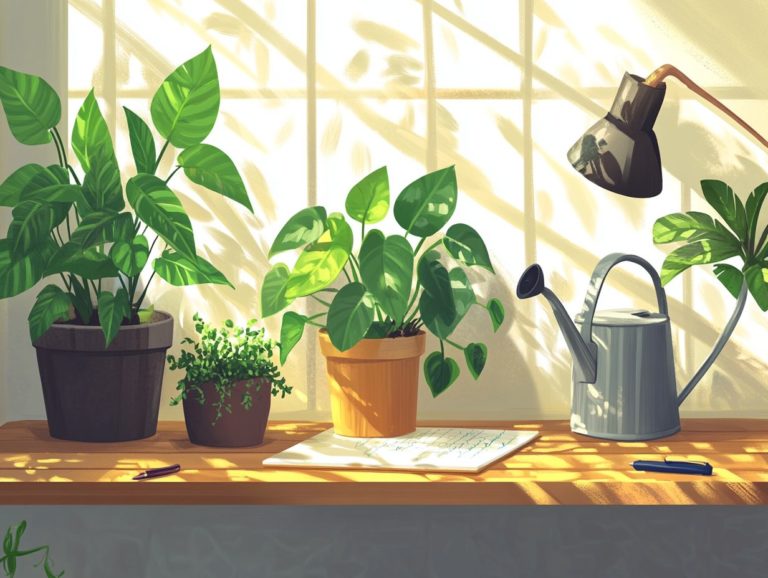Identifying Yellow Leaves in Indoor Plants
Indoor plants infuse your home with vibrancy and life. However, when their leaves begin to turn yellow, it can certainly raise alarm bells.
Understanding the reasons behind this change is essential for anyone dedicated to cultivating a healthy green oasis. Factors such as overwatering, nutrient deficiencies, and pest infestations can all contribute to those troublesome yellow leaves.
Dive into this article to discover common causes, identify signs, and find effective ways to keep your plants thriving!
Act now to ensure your plants not only survive but truly thrive!
Contents
Key Takeaways:

- Yellow leaves in houseplants can be caused by overwatering, underwatering, nutrient deficiencies, and pest infestations.
- To identify the cause of yellow leaves, look for signs such as wilting, discoloration, and pest activity.
- Prevent and treat yellow leaves by using proper watering techniques, fertilizing, and managing pests effectively.
Understanding Yellow Leaves in Indoor Plants
Understanding why your indoor plants develop yellow leaves is essential for anyone who takes pride in their greenery. Yellowing leaves can signal a variety of issues, ranging from overwatering and underwatering to nutrient deficiencies and pest infestations.
Identifying the root cause is crucial for restoring your beloved plants to health. These symptoms often point to environmental stress or improper care.
For example, inadequate light, poor air circulation, temperature fluctuations, or exposure to cold drafts can all trigger yellowing leaves. This condition, known as chlorosis, occurs when leaves turn yellow due to insufficient chlorophyll production.
It’s important to monitor different aspects of your houseplant’s care for their overall well-being.
What Causes Yellow Leaves?
The causes of yellow leaves in your houseplants can be quite varied. Common factors include nutrient deficiencies, overwatering, underwatering, and pesky pests like aphids and spider mites.
Understanding these factors is key to keeping your plants vibrant and healthy. For instance, a deficiency in nitrogen or iron can lead to yellowing, while overwatering can suffocate the roots, resulting in root rot and yellowing foliage. Additionally, understanding leaf spots can also help you identify potential issues early on.
Underwatering, conversely, deprives your plants of the moisture they need, leading to stress that shows up as a change in leaf color. Pests like aphids and spider mites also sap the life out of healthy leaves, causing discoloration and potential wilting.
By being aware of these issues, you can take timely action to restore your plants vitality and keep them looking their best.
Common Reasons for Yellow Leaves
The common culprits behind yellow leaves in your indoor plants typically include overwatering, underwatering, nutrient deficiencies, and pest infestations. Each of these issues presents its own set of challenges in plant care, demanding your attention and expertise.
Overwatering
Overwatering is a frequent offender when it comes to unsightly yellow leaves on your houseplants. It often results in poor soil drainage and root damage.
When your plants are inundated with water, their roots can become starved for oxygen, leading to a cascade of health issues. You might notice leaves turning a mushy brown or drooping dramatically as they struggle under stress.
If you spot mold on the soil surface, that’s a telltale sign of inadequate drainage conditions. To keep your indoor plants thriving, it s essential to use well-draining soil and pots equipped with drainage holes.
Establishing a consistent watering routine generally allowing the top few inches of soil to dry out between watering sessions will significantly benefit your houseplants, enabling them to flourish and maintain their vibrant health.
Underwatering

Underwatering your houseplants can lead to yellow leaves. This happens when they lack the moisture they need to thrive.
Signs of underwatering include wilting, browning edges, and stunted growth. Pay close attention to these symptoms; they mean your plants need water fast.
Establishing a consistent watering routine is crucial. Each plant species has different water needs, so get to know your plants.
Succulents need less frequent watering than ferns, which like consistently moist soil. Regularly check the soil moisture and adjust your watering schedule.
Nutrient Deficiencies
Nutrient deficiencies can also cause yellow leaves. This issue often arises from a lack of essential elements like nitrogen.
It’s not just nitrogen; low levels of magnesium and iron can also lead to yellowing. This means your plants may be struggling to photosynthesize.
Use a well-balanced fertilizer that s rich in micronutrients. Regular applications can replenish soil and promote optimal growth.
Pest Infestations
Pests like aphids and spider mites can harm your plants and cause yellowing. They take essential nutrients and disrupt the plants’ growth cycle.
Look for signs of infestation such as webbing on leaves or sticky residue. These are indicators that your plants need help now!
To control pests, consider using insecticidal soap or neem oil. Both options are safe and friendly to the environment.
Regularly inspect your plants and maintain proper moisture levels to deter pests.
How to Identify the Cause of Yellow Leaves
To effectively identify the cause of yellow leaves in your houseplants, carefully observe the various signs and symptoms related to watering, light exposure, and environmental conditions, such as temperature and air circulation.
Signs and Symptoms to Look For
Recognizing the signs associated with yellow leaves is crucial for effective plant care. Symptoms can indicate issues like overwatering, underwatering, or pest infestations.
If you notice yellowing starting at the tips and working inward, it might signal that your plant is underwatered. Conversely, a uniform yellow hue across the leaf could indicate overwatering.
Nutrient deficiencies, especially a lack of nitrogen, may cause leaves to lose their vibrancy, transitioning from pale green to yellow.
If pests like spider mites or aphids have taken up residence, you may see yellowing along with leaf spots or wilting.
Understanding these signs will enable you to take decisive action, ensuring your beloved houseplants thrive beautifully.
Preventing and Treating Yellow Leaves

To prevent and treat yellow leaves in your houseplants, master a blend of proper watering techniques, effective pest control, and suitable fertilization practices.
Proper Watering Techniques
Employing proper watering techniques is crucial for preventing yellow leaves. Both overwatering and underwatering can significantly impact your plants’ health.
Understanding how to create an efficient watering schedule can truly enhance a plant s vitality. One effective approach is to regularly check how wet or dry the dirt is. Simply insert your finger about an inch deep into the soil to see if it feels dry or damp.
During the warmer months, your plants typically crave more hydration. As the seasons shift, adjust your watering frequency accordingly. Watering in the early morning or late afternoon not only reduces evaporation but also promotes better absorption.
Check the weather forecast to keep your plants happy and healthy! This will help you make necessary adjustments, ensuring your houseplants get just the right amount of water at optimal temperatures, typically between 69 F and 80 F.
Fertilizing and Nutrient Management
Fertilizing and nutrient management are essential in your quest to combat yellow leaves. They ensure your plants receive the vital nutrients needed for good health.
By understanding the different types of fertilizers organic, slow-release, and synthetic you can choose what s best for your specific houseplants. The method of application is equally important. Whether you use liquid feed for a quick nutrient boost or granular options for a gradual release, each method has its unique advantages.
Recognizing signs of nutrient deficiencies, like discoloration patterns or stunted growth, will help you determine what your plants need. A comprehensive approach to care, emphasizing the right fertilizer types and proper application techniques, will lead to lush, vibrant foliage and enhanced overall plant vitality.
Controlling Pests
Controlling pests is crucial for keeping your houseplants healthy. It prevents those pesky yellow leaves that come from infestations like aphids and spider mites.
To tackle these nuisances effectively, explore both natural remedies and chemical solutions that suit your environment and preferences. Natural options, like a simple mixture of water and mild soap or neem oil, can deter pests without harming your plants or the surrounding ecosystem. If the situation gets out of hand, targeted chemical treatments may be necessary.
Implement preventive measures like regular inspections, proper plant care, and ensuring good airflow to minimize the risk of future infestations. By consistently monitoring your plants and using a mix of these strategies, you can cultivate a thriving indoor garden that flourishes beautifully.
Frequently Asked Questions
Spotting Yellow Leaves

To identify yellow leaves in indoor plants, look for leaves that have turned completely yellow, rather than just having yellow spots or veins. Yellow leaves may also appear wilted or droopy. Check the undersides of the leaves for pests or signs of disease.
What Causes Yellow Leaves in Indoor Plants?
Yellow leaves in indoor plants can be caused by various factors. Common causes include overwatering, underwatering, nutrient deficiencies, pests, or diseases. Properly diagnosing the cause is important for effective treatment.
How Can I Prevent Yellow Leaves in My Indoor Plants?
To prevent yellow leaves, make sure to water and fertilize your plants according to their specific needs. Check for pests regularly and address any issues quickly. Providing adequate light and proper air circulation is also important.
Can Yellow Leaves Be Saved on Indoor Plants?
In some cases, yellow leaves can be saved. If the yellowing is due to overwatering or underwatering, adjusting the watering schedule can help the plant recover. If the cause is a nutrient deficiency, fertilizing the plant can be beneficial. However, if pests or diseases are the cause, it may be more difficult to save the affected leaves.
Have your own plant care experiences? Share them with us or ask any further questions!
Should I remove yellow leaves from my indoor plants?
It’s important to remove yellow leaves from indoor plants. Yellow leaves can signal a problem and may attract pests or spread disease.
Taking off yellow leaves helps your plant look better and grow stronger!
Is it normal for indoor plants to have some yellow leaves?
Some yellow leaves on indoor plants are normal, especially as they age. If most leaves are yellow, there’s likely a problem that needs fixing.
Check your plants regularly. Address any issues quickly to keep your plants healthy and vibrant!






